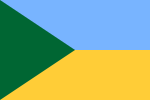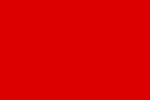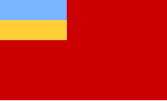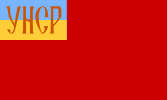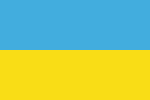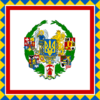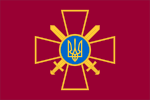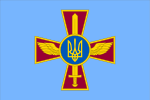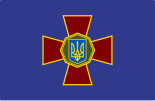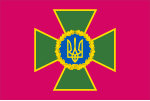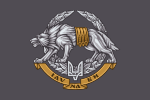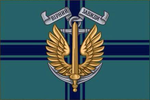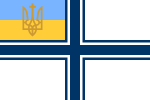Flag of Ukraine
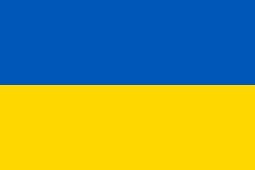 | |
| Use | National flag,civilandstate ensign |
|---|---|
| Proportion | 2:3 |
| Adopted | 22 March 1918(officially adopted) 24 August 1991(de factorestored) 28 January 1992(officially restored, current design) |
| Design | A horizontalbicolourof blue and yellow |
| Sky-Blue Version | |
 | |
| Naval ensign | |
 | |
| Use | Naval ensign |
| Proportion | 2:3 |
| Adopted | 20 June 2006 |
| Design | White with a blue Saint George's cross that extends to the edges of the flag, with the national bicolour in the canton. |
Thenational flagofUkraine(Ukrainian:Державний прапор України,romanized:Derzhavnyi prapor Ukrainy) consists of equally sized horizontal bands of blue and yellow.
The blue and yellow bicolor flag was first seen during the 1848Spring of NationsinLemberg(Lviv), the capital of theKingdom of Galicia and Lodomeriawithin theAustrian Empire.It was later adopted as a state flag by the short-livedUkrainian People's Republic,theWest Ukrainian People's Republic,and theUkrainian Statefollowing theRussian Revolution.
In March 1939, it was also adopted byCarpatho-Ukraine.However, when Ukraine was part of the Soviet Union, the use of the bicolor flag was banned, and it was replaced by theflag of the Ukrainian Soviet Socialist Republic.This flag featured a red background, with an azure bottom and a golden hammer and sickle, along with a golden-bordered red star on top. When the Soviet Union dissolved in 1991, the bicolor flag gradually returned to use before being officially adopted again on 28 January 1992 by theUkrainian parliament.
Ukraine has celebrated theDay of the National Flagon 23 August since 2004.
Design[edit]
Ukrainian lawstates that the colours of Ukrainian flag are "blue and yellow", but other state bodies have determined the colours. In the table below, the colours are presented according to DSTU 4512:2006 technical specifications:[7](TheCabinet of Ministers of Ukrainemade this standard mandatory formilitary funeralflags in 2021.)[8]

| Scheme | Strong azure | Yellow |
|---|---|---|
| Pantone | Pantone Coated 2935 C[7] | Pantone Coated Yellow 012 C[7] |
| RAL | 5019 Azure | 1023 Gold (golden) |
| RGB color model | 0, 87, 183[9] | 255, 215, 0[10] |
| CMYK | 100, 63, 0, 2[9] | 0, 2, 100, 0[10] |
| HEX | #0056B9 | #FFD800 |
| Websafe | #0066CC | #FFCC00 |
There has been disagreement over the shade of blue used in the flag. Both dark blue (Ukrainian:синій) and sky blue (Ukrainian:блакитний) flags were historically used. When the flag was approved in 1992, the dark blue colour was chosen over sky blue for practical reasons: sky blue flags fade very quickly in the sun. Although the official standard was introduced in 2006, some manufacturers keep producing flags that do not match the standard.[11]
-
A Ukrainian independence poster (1917)
-
Leonid KadenyukatNASA,note different shades of blue on the patch and on the flag behind (1997)
-
The strip of the vehicle registration plate
The flag is similar to that of theAustrian stateofLower Austria,theGermancity ofChemnitz,historicalKingdom of Dalmatia(now Croatia) and theHungariancity ofPécs,but all of those flags have a darker shade of blue. The flag is also somewhat similar to that of theMalaysian stateofPerlisand theEnglishcounty ofDurham(without the cross), but has a reversed colour arrangement, lighter shades of blue and yellow, and a differentaspect ratio.
Protocol and use[edit]
This sectionneeds additional citations forverification.(August 2017) |
Article 20 of theConstitution of Ukrainestates that "the State Flag of Ukraine is a banner of two equally sized horizontal bands of blue and yellow colour." (Ukrainian:"Державний Прапор України — стяг із двох рівновеликих горизонтальних смуг синього і жовтого кольорів.").[12][13]

In addition to the normal horizontal format, many public buildings, such as theVerkhovna Rada,use vertical flags. Most town halls fly their town flag together with the national flag in this way; some town flags in Ukraine exist only in vertical form. The proportions of these vertical flags are not specified. When hung like a banner or draped, the blue band should be on the left. When flown from a vertical flagpole, the blue band must face the mast.
The flag did not appear onUkrainian postal stampissues until 1992, when they depicted the flag with the state coat of arms. Since then, the flag has frequently appeared on stamps.Cinderella stampsof theOrganization of Ukrainian Nationalistswere printed outside Ukraine during the Soviet period for patriotic purposes.
Decoration[edit]
Traditionally, the flag may be decorated with agoldenfringesurrounding the perimeter of the flag, as long as it does not deface the flag proper. The tradition began with theflag of the Ukrainian SSR.In addition, theGreat Soviet Encyclopediashows a flag decorated with a gold star. Ceremonial displays of the flag, such as those in parades or on indoor posts, often use a fringe to enhance the allure of the flag. No specific law governs the use of the fringe. Traditionally, theArmy,Guard,NavyandAir Forceuse a fringed flag forparades,colour guardsand indoor displays, while theOffice of the Presidentand local authorities use a fringed flag on all occasions.
Places of continuous display[edit]
Ukrainian flags are customarily displayed continuously in certain locations.
- Maidan Nezalezhnosti,main square ofKyiv,traditional site for political rallies, including large-scale radical protest campaigns (Orange RevolutionandEuromaidan)
- Presidential Administration Building,Verkhovna Rada buildingandGovernment Building
- Kyiv City Council
- Lviv High Castle
- Vernadsky Research Base
- State Border Guard Service of Ukrainesites
- National, regional and local government buildings
- Ukrainian embassies and consulates
Particular days for display[edit]
The flag is hoisted up to its full staff on the following days:
- 1 January:New Year's Day
- 7 January:Christmas (Julian)
- 22 January: Ukrainian Unity and Freedom Day
- 8 March: International Women's Day
- 1 & 2 May:International Workers' Day
- 8 May:Day of Remembrance and Victory over Nazism
- 28 June:Constitution Day
- 23 August:Flag Day
- 24 August:Independence Day
- 13 October:Defenders of Ukraine Day
- 21 November: Day of Dignity and Freedom
- 6 December: Armed Forces Day
- 25 December: Christmas (Gregorian/Neo-Julian)
Display at half-staff[edit]
The flag is displayed athalf-staff(or half-mast) as a sign of respect ormourning.When done nationwide, such a step is proclaimed by the president. Half-mast means flying a flag two-thirds of the way up a flagpole; the top of the flag must be at least a flag's height from the top of the flagpole. Black ribbons indicate mourning on banners that can not be lowered to half-mast.
- 4th Saturday of November:Holodomor Memorial Day
- Other historical cases: mass victims of accidents,Russo-Ukrainian WarandEuromaidan;death and state funeral of Lech and Maria Kaczyński,funeral of Pope John Paul IIandSeptember 11 attacks.
Flag Day[edit]
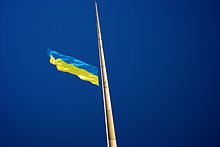
The Day of the National Flag in Ukraine is celebrated on 23 August; it began in 2004.[14]Previously, 24 July was National Flag Day in Kyiv. The first ceremonial raising of the yellow-and-blue Ukrainian flag in modern times took place on 24 July 1990, at the flagstaff of the Kyiv City Council, two years before the flag was officially adopted as the National flag. Since 1992, theIndependence Day of Ukrainehas been celebrated on 24 August. Following a government decree, the flag must be flown from public buildings on this date and certain other holidays; not all are public holidays. Flags must also be flown on parliamentary election days and regional-specific flag days. The public display of flags to mark other events, such as the election of the president or the death of a prominent politician (whereupon flags are flown at half-mast), can be declared at the discretion of theCabinet of Ministers.When flags are flown at half-mast, vertical flags are not lowered. A black mourning ribbon is instead attached, either atop the mast if hung from a pole, or to each end of the flag's supporting cross-beams if flown like a banner.
History[edit]
This sectionmay contain materialnot related to the topic of the article.(November 2022) |


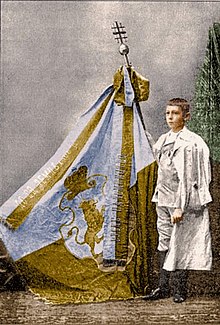
The roots of Ukrainian national symbols come from pre-Christian times when yellow and blue prevailed in traditional ceremonies, reflecting fire and water.[15]The most solid proof of yellow and blue colours can be traced back as far as theBattle of Grunwaldin 1410, in which militia formations from theRuthenian Voivodeshipparticipated.
Blue-yellow, red-black, crimson-olive and especially raspberry colour banners were widely used byUkrainian Cossacksbetween the 16th and 18th centuries. These were not the only possible combinations, since normally Cossacks would fly theirhetman's banners, which were similar to the coats of arms of the nobility. Also, yellow and blue were the colours common on coats of arms inGalicia.In fact, the coat of arms ofLvivto this day remains a golden lion on a blue field.
Some put the starting point of the adoption of the current national flag of Ukraine to 1848 when, during theSpring of the Nationson 22 April 1848, a blue-and-yellow banner was adopted by theSupreme Ruthenian Council[16]in Lemberg (Lviv), the capital of theKingdom of Galicia and Lodomeria,and flew over the city's magistrate for the first time. Although this move did not have significant consequences, the newly formed Ukrainian divisions in the Austrian army used blue-and-yellow banners in their insignia.
During theRussian Revolution of 1905,this flag was used by Ukrainians of theDnieper Ukraine.
 Flag of theKingdom of Ruthenia
Flag of theKingdom of Ruthenia Flags of theLwów landbanner during theBattle of Grunwald,1410
Flags of theLwów landbanner during theBattle of Grunwald,1410
 Banner of theZaporizhian Sichbefore 1775
Banner of theZaporizhian Sichbefore 1775 Flag of theBlack Sea Cossack Hostin 1803
Flag of theBlack Sea Cossack Hostin 1803
Early independence: 1917–1921[edit]



Both blue-yellow and yellow-blue flags were widely used during theUkrainian struggle for independencein 1917. For the first time in the history of theRussian Empire,the blue-yellow flag was flown on 25 March 1917 inPetrogradduring a 20,000-strong massdemonstration.[16]On the territory of Ukraine the national flag was flown for the first time inKyivon 29 March 1917 by soldiers.[16]On 1 April 1917, Kyiv saw a 100,000-strong demonstration where over 320 national flags were flown.[16]Afterwards, similar demonstrations with Ukrainian flags took place across the entire Russian Empire, even beyond ethnic Ukrainian lands.[16]Numerous famous Ukrainian politicians wrote about the 1 April demonstration, includingMykhailo HrushevskyandSerhiy Yefremov,noting that there were blue-and-yellow flags, whileDmytro Doroshenkoclaimed that they were yellow and blue.[16]The blue-yellow flag was flown at the First Ukrainian Military Congress on 18 May 1917.[16]
The official flag established by theUkrainian People's Republicin 1918 was blue-yellow. Instead, they refer to the decision on the Fleet Flag, which was to be light blue–yellow,[17]as an indication that the official flag was light blue–yellow.[18]Also adopted were several other service flags of the Ukrainian People's Republic.[19]
The official flag ofPavlo Skoropadsky'sHetmanatewas also light blue-yellow and remained the same under theDirectorateofSymon Petlura.[citation needed]The flag of theWest Ukrainian People's Republicwas blue-yellow.[citation needed]The statelessMakhnovshchina,which existed during theUkrainian War of Independence,used theblack flag.[20]
Among Ukrainian immigrant organisations, there were proponents of both blue-yellow and yellow-blue flags. Eventually, an agreement was reached to use the blue-yellow flag until the issue could be resolved by an independent Ukraine.
-
 Flag of theUkrainian People's Republic(1917–1921)
Flag of theUkrainian People's Republic(1917–1921) -
 Flag of theCrimean Democratic Republic(1917–1918)
Flag of theCrimean Democratic Republic(1917–1918) -
 Flag of theKuban People's Republic(1918–1920)
Flag of theKuban People's Republic(1918–1920) -
 Flag of theUkrainian State(1918)
Flag of theUkrainian State(1918) -
 Flag of theWest Ukrainian People's Republic(1918–1919)
Flag of theWest Ukrainian People's Republic(1918–1919) -
 Flag of theKomancza Republic(1918–1919)
Flag of theKomancza Republic(1918–1919) -
 Flag of theLemko Republic(1918–1920)
Flag of theLemko Republic(1918–1920) -
 Flag of theHutsul Republic(1919)
Flag of theHutsul Republic(1919) -
 Flag of theKholodny Yar Republic(1919–1922)
Flag of theKholodny Yar Republic(1919–1922) -
 Flag of theMakhnovshchina(1917-1921)
Flag of theMakhnovshchina(1917-1921)
Soviet Ukraine: 1922–1991[edit]

During Soviet rule, the Ukrainian flag was banned,[23]and anyone displaying it could be criminally prosecuted for "anti-Soviet propaganda". The first flag of the Ukrainian Soviet Socialist Republic was adopted on 10 March 1919, to serve as the symbol of state ofSoviet Ukraine.Details of the official flag changed periodically before the break-up of the Soviet Union in 1991, but all were based on the red flag of theOctober Revolutionin Russia and an exact replica of the flags of the neighbouringRussian SFSR. The first flag was red with the gold Cyrillic sans-serif lettersУ.С.С.Р.(U.S.S.R., acronym forUkrainskaya Sotsialisticheskaya Sovetskaya Respublikain theRussian language). In the 1930s, a gold border was added to the flag. In 1937, a new flag was adopted, with a small gold hammer and sickle added above the gold Cyrillic serifУ.Р.С.Р.(U.R.S.R., forUkrainska Radianska Sotsialistychna Respublikain the Ukrainian language).
-
 Red flag(1917)
Red flag(1917) -
 Flag of theUkrainian People's Republic of Soviets(1917–1919)
Flag of theUkrainian People's Republic of Soviets(1917–1919) -
 Flag of theUkrainian People's Socialist Republic(1919)
Flag of theUkrainian People's Socialist Republic(1919)
Interbellum and Reichskommissariat Ukraine[edit]
The Organisation of Ukrainian Nationalists is a Ukrainian political organisation which as a movement was originally created in 1929 in Western Ukraine (interwar Poland at the time). For a long time, the OUN did not officially have its own flag; however, during the Hungarian and Polish aggression against theRepublic of Carpathian Ukrainein 1939, Carpathian Sich, a militarised wing of the OUN, adopted as its flag a design taken from the OUN's emblem – a golden nationalistic trident on a blue background. The flag was finalised and only officially adopted by the organisation in 1964 at the 5th Assembly of Ukrainian Nationalists.
TheUkrainian Insurgent Armywas a Ukrainian nationalist paramilitary and later partisan army that engaged in a series of guerrilla conflicts during World War II againstNazi Germany,the Soviet Union,Czechoslovakia,and both underground andcommunist Poland.The group was the military wing of the Organisation of Ukrainian Nationalists — Bandera faction (the OUN-B), originally formed in Volyn in the spring and summer of 1943. Its official date of creation is 14 October 1942. The battle flag of the UPA was a 2:3 ratio red-and-black banner. The flag continues to be a symbol of the Ukrainian nationalist movement. The colours of the flag symbolise 'Ukrainian red blood spilled on Ukrainian black earth'.
-
Flagof the Ukrainian Insurgent Army andOrganisation of Ukrainian Nationalists (Bandera faction)
In 1949, the flag of the Soviet Ukraine was changed once again.[24]TheSoviet Unionmanaged to obtain two additional seats in theUnited Nationsby adding Ukraine andByelorussiaasmember states.[24]The flag change came about because all the Soviet flags were the same.[24]The new Ukrainian flag consisted of red (top, 2/3) andazure(bottom, 1/3) stripes,[24]with the golden star,hammer and sicklein the top left corner. Communist party leaders such asNikita KhrushchevandLazar Kaganovichfeared using words like 'light blue' and 'blue' in the official flag colours, as they were the terms used by theUkrainian diaspora.[24]
During the Soviet period, multiple unsanctioned attempts to hoist the national blue-and-yellow flag were made. In 1958, an underground group was established in the village of Verbytsia,Khodoriv Raion;its members raised national flags and spread anti-Soviet pamphlets under cover of darkness.[25]
Return of the national flag[edit]
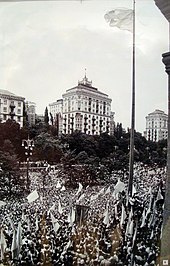
Under the influence ofMikhail Gorbachev's policies ofperestroikaandglasnost,individual Soviet republics gained a strengthened sense of national identity, leading to thecollapse of the Soviet Unionin 1991. This was particularly true for the threeBaltic statesandWestern Ukraine,which were the last territories annexed into Soviet Union. The national awakening was accompanied by attempts to restore historical national symbols. In 1988, theSupreme Soviet of the Lithuanian SSRre-establishedLithuania's national flag and coat of arms as the state symbol. The parliaments ofLatviaandEstoniasoon followed suit.
The events in the Baltic countries soon led to similar patterns in Ukraine. In particular, West Ukraine and theUkrainian SSR's capital city ofKyivwere the scenes of near-constant political demonstrations, in which yellow-and-blue flags were waved by demonstrators.
- On 14 March 1990, the Ukrainian flag was raised for the first time since the establishment of the Soviet Union in the small city ofStryi.[26]
- On 20 March 1990, theTernopiltown council voted on the use and re-establishment of the yellow-and-blue flag and thetryzubandShche ne vmerla Ukrainynational anthem. The same day, the yellow-and-blue national flag was flown for the first time in 80 years on a governmental building in Kyiv, replacing the then-officialred-azure flagof the Ukrainian SSR.
- On 28 April 1990, theLvivoblast council (oblasna rada) also allowed the use of the national symbols of Ukraine within the Oblast.
- On 29 April 1990, the yellow-and-blue flag was flown from the Ternopil city theatre's flagstaff without theflag of the Soviet Unionhanging above it.
- After 24 July 1990, the yellow-and-blue flag was flown for the first time over an official governmental building, theKyiv City Council,onMaidan NezalezhnostiSquare ofKhreshchatykStreet.[27]
- After thedeclaration of independence of Ukraineon 24 August 1991, the national yellow-and-blue flag flew for the first time over theUkrainian Parliament (Verkhovna Rada)building on 4 September 1991.
The blue and yellow flag was provisionally adopted for official ceremonies in August 1991 followingUkrainian independence,before officially being restored on 28 January 1992 by theParliament of Ukraine.[28][29]At the beginning of the2022 Russian invasion of Ukraine,landmarks all over the world were lit up with the colours of the Ukrainian flag, while numerous cities raised the Ukrainian flag in solidarity.[30][31]Kastuś Kalinoŭski Regiment,an independentBelarusianvolunteer regiment, also adopted the colours of the Ukrainian flag in its insignia.
Controversies and criticism[edit]
Origin[edit]
One claimed version is that, since one of the first known coloured depictions of thecoat of arms of Kyivwas mainly in yellow-blue colours, this tradition may have existed since the time of the Nordic-SlavicGrand Prince of KyivVolodymyr the Great.However, the blue-yellow colouring dates back toKievan Rus’,as an early version of theTryzub,Ukraine's national coat of arms, sported the same colouring as the seal ofSviatoslav Iof Kyiv (c. AD 945). During the 1709Battle of Poltava,the Cossacks followingMazepafought under yellow-blue banners, while their Swedish allies were under yellow ones. Some Cossacks and noblemen had coats of arms in yellow and blue.[32]
Yellow-blue versus blue-yellow[edit]
Ukrainians commonly refer to the flag as "yellow and light blue" (Ukrainian:жовто-блакитний,zhovto-blakytnyi)[33]—a different version of the flag used during UNR (Ukrainian National Republic) years (1917–1921) with yellow on the top and blue on the bottom. The yellow on the top allegedly represents golden domes (cupolas) of Christian churches and the blue theDnieperriver.
The head of theUkrainian Heraldry Society,Andriy Grechylo,points to the fact that the discussion about order of colours was taking place as far back as 1918.[24]Nonetheless, both governments of the Ukrainian People's Republic as well as the Ukrainian State defined that the upper half would be light-blue, while the lower would be yellow.[24]During 1918 it was taken into consideration that light blue would lose its shade under sun, therefore it was decided to make the colour darker.[24]
Already in the 1918 draft of the Constitution of the Ukrainian People's Republic, the order of colours was defined as blue and yellow.[24]The same order could be found in legislative acts of theWest Ukrainian People's Republicfor November 1918 and theRepublic of Carpathian Ukraineon 15 March 1939.[24]The argument on the order of colours was taking place in theUkrainian diasporaas well.[24]In 1949 it was decided that, until Ukraine defined a single state flag, the diaspora would use the blue-and-yellow banner.[24]
Attempts to revive Soviet flags[edit]
On 21 April 2011, theVerkhovna Radapassed a law allowing theVictory Bannerto be raised on Victory Day.[34]The current Victory Banner was adopted in Russia in 2007. On 20 May 2011, the law was signed by thePresident of UkraineViktor Yanukovych.[35]On 17 June 2011, theConstitutional Court of Ukrainerecognised the law as unconstitutional and proposed that the parliament implement required amendments to theConstitution of Ukraine.[36]
On 9 April 2015, the Ukrainian parliament passed legislation ondecommunization,banning the promotion of symbols of "CommunistandNational Socialisttotalitarian regimes".[37]Since then, Soviet symbols, like the Victory Banner, have only been allowed in cemeteries.[38][39]
Soviet flags have been flown in territoriesoutside of the government's controlafter Russiainvaded the countryin 2022.[40]
Flag of the head of state[edit]
Throughout the history ofUkraine,variousheads of statehave used different flags. The designs differ according to the historical era they were used in and in accordance with the political scene inUkraineat the time. The first flag to be used by ahead of state of Ukrainewas that ofPavlo Skoropadskyi.A standard for thePresident of the Ukrainian People's Republic in exileappeared around 1930. The current design, theflag of the president of Ukraine,was adopted in 1999. In 2022, the president of Ukraine used a variant where the left side of the blue upper-half contains the yellowTryzub.[41]
-
 Standard of thePresident of the Ukrainian People's Republic in exile
Standard of thePresident of the Ukrainian People's Republic in exile
Military flags[edit]

-
Armed Forces
-
Ground Forces
-
Air Force
-
National Guard
-
Navy
Historical[edit]
-
 Flag of the Soviet Union used to represent theSoviet Army(1955–1991)
Flag of the Soviet Union used to represent theSoviet Army(1955–1991) -
 Flag of theSoviet Air Force(1924–1991)
Flag of theSoviet Air Force(1924–1991) -
 Flag of theSoviet Airborne Troops
Flag of theSoviet Airborne Troops
-
 Flag of theSoviet Navy(1953–1991)
Flag of theSoviet Navy(1953–1991)
See also[edit]
- List of Ukrainian flags
- Flags of the regions of Ukraine
- Coat of arms of Ukraine
- National colours of Ukraine
References[edit]
- ^abSigning the Agreement to eliminate the USSR and establish the Commonwealth of Independent States.
- ^ab"Figure Skating Drama - Part 2 - The Lillehammer 1994 Olympic Film".youtube.
- ^ab"Церемонія підняття Прапора України у місті Львові".youtube(in Ukrainian). 23 August 2016.
- ^ab"Урочиста церемонія підняття Державного Прапора України 23.08.17".youtube(in Ukrainian). 23 August 2017.
- ^ab"ДЕРЖАВНИЙ ПРАПОР УКРАЇНИ ПІДНЯТО У ЛЬВОВІ".youtube(in Ukrainian). 23 August 2019.
- ^ab"У Вінниці підняли найбільший в області Державний прапор України".youtube(in Ukrainian). 23 August 2021.
- ^abcKuzemska, N. (2006)."ДСТУ 4512:2006. Державний прапор України. Загальні технічні умови"[DSTU 4512:2006. National flag of Ukraine. General technical conditions].uk.wikisource.org(in Ukrainian). Research Institute of Design of NAU, Ukrainian Research Institute of Textile Industry.Retrieved9 March2022.
- ^"Про затвердження Порядку виготовлення Державного Прапора України"[On the Approval of the Rules for the Production of the State Flag of Ukraine] (in Ukrainian). Verkhovna Rada of Ukraine. 20 October 2021.Retrieved3 March2024.
- ^ab"PANTONE® 2935 C - Find a Pantone Color | Quick Online Color Tool | Pantone".pantone.Archived fromthe originalon 15 July 2021.Retrieved4 June2020.
- ^ab"PANTONE® Yellow 012 C - Find a Pantone Color | Quick Online Color Tool | Pantone".pantone.Archived fromthe originalon 26 May 2019.Retrieved4 June2020.
- ^Martynnyk, Bohdanna (23 August 2020)."Як комуністи ледь не зіпсували наш синьо-жовтий стяг - Спецтема"(in Ukrainian). Ekspres.Retrieved3 March2024.
- ^Constitution of Ukraine.
- ^Конституція України.Верховна Рада України(in Ukrainian).
- ^Ukraine celebrates National Flag DayArchivedOctober 7, 2013, at theWayback Machine,Xinhua News Agency(August 23, 2012)
Ceremony of hoisting Ukraine's national flag held at presidential administration,Kyiv Post(August 23, 2011)
Україна відзначає День Державного прапора "On Tuesday, August 23, all of Ukraine celebrates National Flag Day. Measures to raise the national flag are planned throughout the country."Archived1 August 2013 at theWayback Machine,1+1(August 23, 2011) - ^Saprykov, V. (30 May 2003).Флаг Украины[Flag of Ukraine].geraldika.ru(in Russian).Retrieved2 October2017.
- ^abcdefg"Синьо-жовтий чи жовто-блакитний? Міфи про" перевернутий "прапор (Blue-yellow or yellow-blue? Myths about the flipped flag)".Ukrayinska PravdaІсторична правда.14 January 2014.Retrieved4 March2022.
- ^Rozovyk, D. F. (1999).Документи та матеряли: Про створення української національно-державної символіки у роки визвольної боротьби (1917-1920 рр.)[Documents and materials: On the creation of Ukrainian national-state symbols during the battle for liberation (1917-1920)](PDF).Ukrainian Historical Journal(in Ukrainian).4.Kyiv: history.org.ua: 115–121.ISSN0130-5247.Archived fromthe original(PDF)on 5 July 2007.
- ^Chmyr, Mykola (2006).Українське військо у ХХ-ХХІ сторіччі: 'Командні хоругви' Галицької Армії (серпень 1919 р.)[Ukrainian Army in the 20th-21st Century: 'Command banners' of the Galician Army (August 1919)].vijsko.milua.org(in Ukrainian). Archived fromthe originalon 4 July 2007.Retrieved2 October2017.
- ^Grechylo A. Ukrayinska Terytorialna Heraldyka. Lviv, 2010, pp. 98–118.ISBN978-966-02-5259-2
- ^Darch, Colin (2020).Nestor Makhno and Rural Anarchism in Ukraine, 1917-1921.London:Pluto Press.p. 102.ISBN9781786805263.OCLC1225942343.
- ^Smith, Ned (24 February 2001)."Green Ukraine / Ukrainian Far East (1921, Russian Far East)".FOTW "Flags Of The World".CRW Flags.Retrieved24 October2018.
In "Flags of Non-Russian Peoples Under Soviet Rule" by Prof. Walter Trembicky [tbc69], pages 134 and 135, it mentions two proposed flags for Green Ukraine, or the Ukrainian Far East, neither of which was officially adopted, since the movement quickly proved abortive. There are simple black & white line drawings illustrating the two proposed flags on p. 133 of [tbc69]. The green in the two flags was described as dark or deep green.... One [of the two proposed flags] was the Ukrainian blue-over-gold bicolor with a green triangle at the hoist.
- ^Trembicky, Walter (1969).Flags of Non-Russian Peoples Under Soviet Rule.Flag Research Center. pp. 134, 135.
- ^"The Revolution On Granite: Ukraine's 'First Maidan'".Radio Free Europe/Radio Liberty.Retrieved4 March2022.
- ^abcdefghijklGazeta.ua (23 August 2013)."Хрущов і Каганович боялися слова" жовто-блакитний "(Khrushchev and Kaganovich were afraid of the word" zhovto-blakytnyi ")".Gazeta.ua(in Ukrainian).Retrieved4 March2022.
- ^"Невідомі прапороносці. Жовто-блакитний проти червоного (Unknown flag-bearers. Yellow-blue against Red)".Ukrayinska PravdaІсторична правда.29 July 2011.Retrieved4 March2022.
- ^"History of evolution of the State Flag of Ukraine".Ukrinform(in Ukrainian). 23 August 2015.Retrieved4 March2022."Укрінформ - актуальні новини України та світу".Archived from the original on 17 August 2015.Retrieved23 August2015.
{{cite web}}:CS1 maint: bot: original URL status unknown (link) - ^"22 роки тому в Києві офіційно підняли синьо-жовтий прапор (Twenty two years ago in Kyiv officially was raised the blue-yellow flag)".BBC News Україна(in Ukrainian). 24 July 2012.Retrieved4 March2022.
- ^"Ukraine's national flag celebrating 25th anniversary today".UNIAN.Retrieved4 March2022.
- ^Trach, Nataliya (26 August 2016)."The story behind 2 top Ukrainian symbols: National flag and trident".Kyiv Post.Retrieved27 August2016.
- ^"Town of Blue Mountains Info:Town Raises Ukrainian Flag in Support and Solidarity for the People of Ukraine".Archived fromthe originalon 11 April 2022.Retrieved18 March2022.
- ^"VIDEO: Ukraine invasion: Europe's landmarks turned blue and yellow in solidarity with Kyiv".25 February 2022.
- ^Vannier, Alexis (24 August 2021).""CHTCHE NE VMERLA UKRAÏNY": HISTOIRE DU DRAPEAU DE L'UKRAINE ".taurillon.org(in French).Retrieved16 March2022.
- ^A little less often they use also "yellow and blue", "blue and yellow" and "yellow and azure".
- ^"РАДА ЗОБОВ'ЯЗАЛА ВИВІШУВАТИ ЧЕРВОНІ ПРАПОРИ НА 9 ТРАВНЯ (Rada enforced raising red flags on the May 9)".Ukrayinska PravdaІсторична правда(in Ukrainian). 21 April 2011.Retrieved4 March2022.
- ^"ЯНУКОВИЧ ПІДПИСАВ ЗАКОН ПРО ЧЕРВОНИЙ ПРАПОР (Yanukovych signed the law about the Red Banner)".Ukrayinska PravdaІсторична правда(in Ukrainian). 21 May 2011.Retrieved4 March2022.
- ^"КС Украины признал неконституционным использование красного знамени Победы (CC of Ukraine recognised the use of Red Victory Banner as non-constitutional)".Russian Gazette Российская газета(in Russian). 17 June 2011.Retrieved4 March2022.
- ^Peterson, Nolan (10 April 2015)."Ukraine Purges Symbols of Its Communist Past".Newsweek.Retrieved17 May2015.
"Rada bans Communist, Nazi propaganda in Ukraine".Interfax-Ukraine.9 April 2015.Retrieved17 May2015.
Hyde, Lily (20 April 2015)."Ukraine to rewrite Soviet history with controversial 'decommunisation' laws".The Guardian.Archived fromthe originalon 16 May 2015.Retrieved17 May2015. - ^Shevchenko, Vitaly (14 April 2015)."Goodbye, Lenin: Ukraine moves to ban communist symbols".BBC News.Retrieved17 May2015.
- ^"Ukraine lawmakers ban 'Communist and Nazi propaganda'".Deutsche Welle.9 April 2015.Archivedfrom the original on 1 October 2015.Retrieved11 February2023.
- ^Young, Pareisa (11 March 2022)."Ukraine: Russian troops flying Soviet flag, symbol of 're-establishing Russian domination'".The Observers -France 24.Archivedfrom the original on 27 April 2022.Retrieved4 May2022.
- ^Basu, Zachary (1 March 2022)."Zelensky tells European Parliament" nobody is going to break us "in emotional appeal".Axios.Retrieved4 March2022.
External links[edit]
- UkraineatFlags of the World
- DSTU 4512:2006Technical specifications from DSTU (Ukrainiannational standards body) regarding flag of Ukraine, in Ukrainian. 1 September 2006.
- Ukraine – Vexillographia
- Armed Forces Flag in Ukraine
- Departmantal Flag and Emblem in Ukraine
- Brief history of the flagArchived18 December 2011 at theWayback Machineat the Science Library of Franko National University (Lviv).
- "About Ukrainian flag".Statement of the Presidium of the Supreme Council of Ukraine. 18 September 1991.
- "About the State Flag of Ukraine".State of the Supreme Council of Ukraine. 28 January 1992.


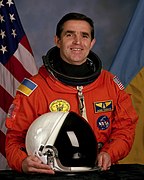

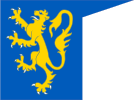






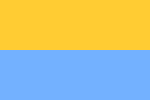


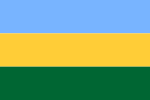
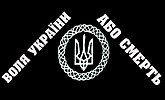

![Version of the flag of the Ukrainian Far Eastern Republic (1917–1922) in Siberia[21][22]](https://upload.wikimedia.org/wikipedia/commons/thumb/9/96/Flag_of_Green_Ukraine.svg/150px-Flag_of_Green_Ukraine.svg.png)
